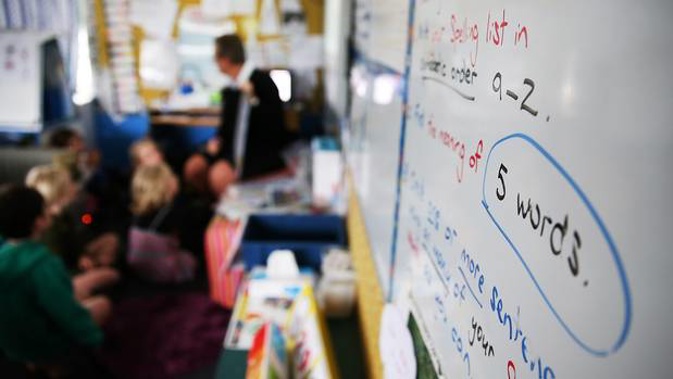
KEY POINTS:
- Regional boards proposed to take over most legal roles of school boards, including appointing principal.
- Out-of-zone enrolments would be capped.
- Intermediate schools would be abolished and replaced by junior colleges (Years 7-10), with senior colleges (Years 11-13) replacing many secondary schools.
- New funding system based on individual student characteristics to replace decile funding.
- Education Review Office and NZ Qualifications Authority abolished.
A taskforce is proposing the biggest shake-up in the education system for 30 years, removing most of the powers currently held by school boards of trustees.
The taskforce led by former principal Bali Haque proposes about 20 new regional education boards, or "hubs", to "assume all the legal responsibilities and liabilities currently held by school boards of trustees".
It says competition between schools under the free-market system known since 1989 as Tomorrow's Schools has led to a flight of students from poorer schools, which has made it harder for those schools to serve the country's most disadvantaged students.
To fix this, the proposed regional hubs would manage school zoning and funding, employ teachers and principals and take over the process when any student is suspended, removing a principal's power to expel students.
/arc-anglerfish-syd-prod-nzme.s3.amazonaws.com/public/AQR3374Q5ZH2JM4J6RBBHQVAIM.jpg)
The role of school boards of trustees would be reduced to "providing advice to the principal" on the school's curriculum and other issues, working with the education hub on the school's strategic and annual plans, and having a role in appointing the principal.
School boards would have "up to 50 per cent representation" on panels initiated by the education hub to appoint a new principal, and would have a veto over the final choice if a principal.
Other recommendations include:
• Abolishing intermediate schools, creating either junior colleges (Years 7-10) and senior colleges (Years 11-13) or full primary schools (Years 1-8) and secondary schools (Years 9-13).
• Abolishing the decile-based funding system, replacing it with a new system based on the numbers of students with recognised learning disadvantages in each school and doubling the disadvantage-based funding from 3 per cent to 6 per cent of total funding.
• Putting an upper limit on "donations" that state schools can request from parents.
• Doubling management funding for primary schools so that they are funded on the same basis as secondary schools.
• Abolishing the Education Review Office (ERO) and the NZ Qualifications Authority (NZQA), allocating their functions to the education hubs, the Ministry of Education and a proposed new Education Evaluation Office.
The proposals have not yet been endorsed by the Government, which will make final decisions next year.
But, if adopted, they would reverse most of the decisions made in 1989 when regional education boards were abolished, school boards of trustees were given powers to appoint principals and enrol students, and the old Education Department was split into multiple agencies including ERO and NZQA.
The taskforce says the 30-year experiment has produced a system that has one of the world's widest gaps between high- and low-achieving students and "does not work for too many students", particularly Māori, Pacific and migrant students and those with extra learning needs.
"It is disturbing to hear their experiences of regularly being discounted or marginalised in classrooms, or of feeling that they are not expected to achieve as well as others," it says.
It sees competition as the root of the problem and proposes the regional education hubs to create "a system that supports interdependence and collective responsibility between all of its parts".
It suggests that each hub should take control of an average of 125 schools.
Although this is not spelt out, it might mean four hubs in Auckland where there are now 551 schools, two in other large regions such as Waikato (309 schools) and Canterbury (289), and one each in smaller regions such as Northland (151), Bay of Plenty (159) and Hawke's Bay (126).
There could also be a national hub for Māori-language schools.
The hubs would replace the Ministry of Education's regional offices and would be centrally controlled, with boards of directors appointed by the Education Minister. At least half of the directors would be "practising educators", and some would represent local iwi.
The hubs would appoint school principals, giving them ongoing jobs within the hub and appointing them to particular schools for five-year terms.
"This would allow education hubs to provide opportunities to principals/tumuaki to gain experience in a variety of school settings and to contribute where their expertise is most needed," the taskforce says.
The hubs "would be the legal employer of teachers/kaiako, but principals/tumuaki would appoint and performance manage all their staff within national guidelines with advice and guidance from the education hub if required".
Teachers might be seconded to other schools within the hub "so that their expertise could be shared more widely".
The taskforce says the current system where most students spend six years in primary school, two years in intermediate and five years in high school is "unnecessarily disruptive".
It says all intermediate school principals it spoke with "were in agreement that a longer period of 'middle schooling' would provide greater stability for their students and enable better support for their learning and wellbeing".
Creating junior colleges for Years 7-10 would leave senior colleges for the last three years of schooling, which could have more "relaxed" rules.
"For example, senior students (Years 11-13) might not be required to wear uniform, they might attend school at different hours than junior students, and they might operate a timetable split between school and tertiary, or even between school and employment, training or work experience," the taskforce says.
However the taskforce acknowledges that some regions would be too small to make junior and senior colleges viable, so some hubs might choose to keep full primary and secondary schools or area schools.
Take your Radio, Podcasts and Music with you









